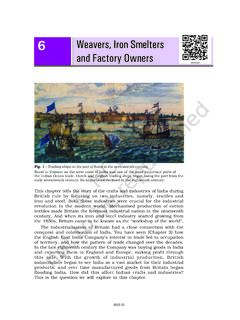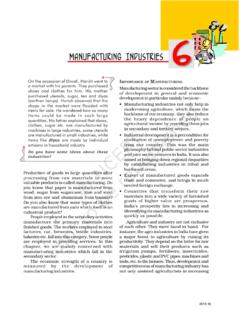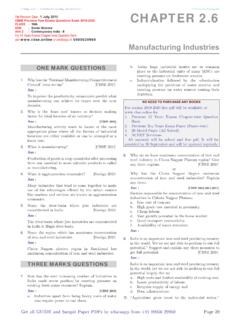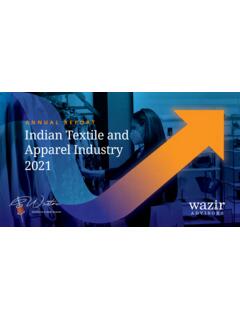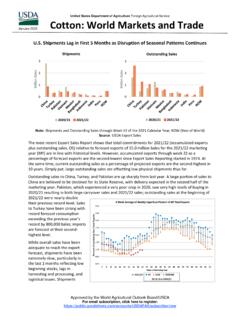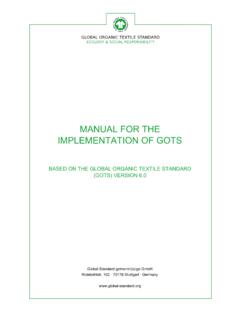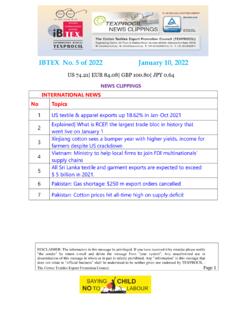Transcription of Report on Bangladesh Textile and Garment Industry
1 Page | 1 Report on Bangladesh Textile and Garment Industry Page | 2 Table of Contents Sl. No. Particulars Page No. Acronyms 4 Overview of Vietnam Economy 5-8 Country Background 5 Socio Economic Profile 5 Economic Outlook 6 Bangladesh s Gross Domestic Product (GDP) and its Growth Rate 6 Recent Trend in Bangladesh 7 Business Environment and Investment Climate in Bangladesh 9-10 Profile of the Private Sector 9 Trade policy Environment and market Access 9 Investment Climate and incentives 9 Legal and Regulatory Framework 9-10 Physical Infrastructure 10 Cost of Doing Business and Economic Freedom 10 Skills Level and Their Availability 10 Overview of Textile and Garments Industry Sector 11-22 Background 11 Raw Materials for Textile and Garment Sector 11 cotton Sub-Sector 11 Yarn 13 Fabric 14 Silk 14 The Primary Textile Sector in Bangladesh 15 Spinning Sub-Sector 15 Weaving Sub-Sector 16 Knitting Sub-Sector 16 Handlooms Sub-Sector 16 Dyeing.
2 Printing and Finishing Sub-Sector 17 Overview of Readymade Garment Sector in Bangladesh 17 Grow in Garment Exports from Bangladesh 17 Export of Apparels by Bangladesh 18 Recent Investment Trend I Textile and Apparel Sector 19 Capacity Utilization and Production Orientation of Garment in Bangladesh 22 Incentives for Textile and Garment Industry provided by the Government 23-24 Cash Incentives and Subsidy for the Textile Industry Sector 23 Non-Cash Incentives for Textile and Garment Sector 23 Fiscal and Non-Fiscal Incentives for Investment 23 Value Chain of Textile and Garments in Bangladesh 25-27 Costing of Garments in Bangladesh 25 Value Chain of Garment in Bangladesh 25 Page | 3 Impact on Other Related Industries across the Value Chain 28-30 Economic Development 28 Employment Creation 29 Spill Over Impacts 29 Challenges Faced by Bangladesh Garments and Textile Industries 31-32 Challenges Faced by Bangladesh 31 Opportunities and Growth Potentials 31 Recent Initiatives to Face Challenges 32 Appendix-1 Page | 4 Acronyms BEPZA Bangladesh Export Processing Zones Authority BTMA Bangladesh Textile Mills Association EBA Everything but Arms EPB Export Promotion Bureau EPZs Export Processing Zones FDI Foreign Direct Investment GDP Gross Domestic Products ICSID International Centre for Settlement of Industrial Disputes MIGA Multi-Literal Investment Guarantee Agency MFA Multi-Fiber Arrangement ODA Official Development Assistance OPIC Overseas Private Investment Corporation RMG Readymade Garment SAARC
3 South Asian Association of Regional Cooperation TIFA Trade and Investment Facilitation Agreement WAIPA world Association of Investment Promotion Agencies WB world Bank WIPO world Intellectual Property Organization WTO world Trade Organization Page | 5 Overview of Bangladesh Economy Country Background Bangladesh is located in South Asia and shares its borders with India and Myanmar and impendence in 1971. It is the seventh most populous country in the world with a population density of 1, people per square km (2009 estimate). Over 50% of Bangladesh s GDP comes from the services sector. T wo-third of the country s population is engaged in agricultural activities, with most of them growing paddy. The Bangladesh economy is helped by its big readymade Garment (RMG) Industry sector, which contributes more than two-thirds of the country s trade.
4 The major challenge to prosperous growth is the vulnerability of the land to cyclones and floods. However, even with such challenges, Bangladesh has experienced an annual growth rate of 5% since 1990, largely contributed by remittances from the expatriates and exports, where RMG sector has the lion share of total export earnings. Socio-Economic Profile* Area 147,570 km2 Population 162,221,000 (2009 estimate) Labor Force: million (2008 est.) Male: 68% Female: Population Growth Rate: (2009 est.) GDP (nominal) 2009 Total $ billions Per capita income (nominal) US$ 624 Agriculture as % of GDP Industry as % of GDP Services as % of GDP 20%(2009 estimate) 28%(2009 estimate) 52% (2009 estimate) Literacy Rate Religion Islam , Hinduism , Buddhism , Christianity , Animism Border Main Sectors Lying north of the Bay of Bengal, on land it borders India and Myanmar, and it is a close neighbor to China, Nepal and Bhutan.
5 Agriculture, Manufacturing, Textile , Investment and Remittance Main Industry Garments and textiles , food processing, frozen food, pharmaceuticals, leather and footwear, ceramics, gas, cement, chemical fertilizer, glass, tires, oil refinery, coal, steel, paper, etc. Major Exports Commodities Garments, textiles , jute and jute goods, ships, leather, frozen fish and seafood, pharmaceuticals, ceramics, cement, etc. Major Investors USA, EU, Japan, China, Australia, Singapore, Germany, UK, South Korea, Thailand and Malaysia. Total Approved FDI inflow $ billion 2009 estimated Sea ports Chittagong and Mongla Seaport Exchange Rate Taka per US dollar - (August 2010) *(Source: CIA world Fact Book, 2010) Page | 6 Economic Outlook Bangladesh is virtually located as a bridge between the emerging markets of South Asia and fastest growing markets of South East Asia and ASEAN countries.
6 With the proposed concept of a "Bay of Bengal Growth Triangle" with its apex Chittagong port extending south-west to Calcutta, Madras and Colombo and the south-eastern arm extends through Yangon, to Thailand, to Penang with the third arm to Colombo, this region should have growing attention of the investment world . Bangladesh has the potential to be an entry port to the region covering Bangladesh , Nepal, Bhutan, eight north-east Indian states (of Assam, Meghalaya, Monipur, Imphal, Arunachal, Nagaland, Mizoram and Tripura) and resource-rich northern Myanmar, a land locked region. Bangladesh is poised to become a regional hub where activities relating to assembling, manufacturing, trading and services, would be some of the areas that are picking up over the years.
7 The current macroeconomic situation in the country is, by and large, stable, characterized by a manageable fiscal deficit and a quite low current account deficit. This reflects the continued high growth of exports, increased flows of remittances, moderate growth in money supply as well as that of imports. The stable macroeconomic situation is an outcome of a mixture of prudent monetary and fiscal policies that are being pursued. Figure shows five-year inter temporal GDP growth path of Bangladesh . Figure : Average Growth Rate of GDP in Bangladesh (Based on 5-Year Average) Source: Bangladesh Economy: Recent Macroeconomic Trend, 2008 Bangladesh s Gross Domestic Product (GDP) and its Growth Rate Since 1990 Bangladesh has seen major improvements on a number of development indicators, including rates of economic growth, poverty reduction, population regulation, infant mortality, and literacy.
8 Its economic progress over the past 15 to 20 years has led the world Bank (WB) to state that Bangladesh could become a middle income country (per capita gross national income of US$ 875) by 2016. The WB also states that a sustained growth rate of percent is required to make this transition. According to the world Bank, Bangladesh has achieved a growth rate of in FY2008-09. The trend of gross domestic product of Bangladesh at market prices estimated by the IMF is shown in the Figure below. Figure : Trend of GDP in Bangladesh (million Taka) Page | 7 The economy has grown 5-6% per year since 1996 despite political instability, poor infrastructure, corruption, insufficient power supplies, and slow implementation of economic reforms. Although more than half of GDP is generated through the service sector, about 45% of Bangladeshis are employed in the agriculture sector.
9 Sectoral contribution to GDP can be seen in the figure shown below: Figure : Sectoral Contributions to GDP Growth Source: Bangladesh Economy: Recent Macroeconomic Trend, 2008 Garment exports, totaling US$ billion in FY2009-10 and remittances from overseas Bangladeshis totaling US$ billion in FY2009-10 accounted for almost 25% of GDP. The Textile Industry in Bangladesh , now the sixth largest exporter of apparel in the world after a decade of spectacular economic growth, has positioned itself to benefit from the current global economic crisis. Production of ready-made garments (RMG) and knitwear is at an all-time high. Recent Trend of Investment in Bangladesh In Banglade sh, due to sharp decline in the ava ila bility of Official Development Assistance (ODA) and limitations of capital formation and export earnings, the need for Foreign Director Investment (FDI) ha s become a major issue.
10 Government policies tried to induce foreign investments not only for capital formation but also to acquire technology and management skills be sides ha ving access to the export markets, and help integrate the domestic economy with the global economy. Figure below shows trend on investment: Figure : Investment as Percent of GDP (Based on 5-Year Average) Source: Bangladesh Economy: Recent Macroeconomic Trend, 2008 Page | 8 In Bangladesh , FDI originated from USA, EU, Japan, UK, Malaysia, Hong Kong, Saudi Arabia, Singapore, Norway, Germany, South Korea and Thailand. From 1991-1992 to 1999-2000 as many as 10,412 industrial projects both local & foreign have been registered with BOI having total investment outlay of US$ 19074 million with employment opportunities of 1,442,568 persons.

